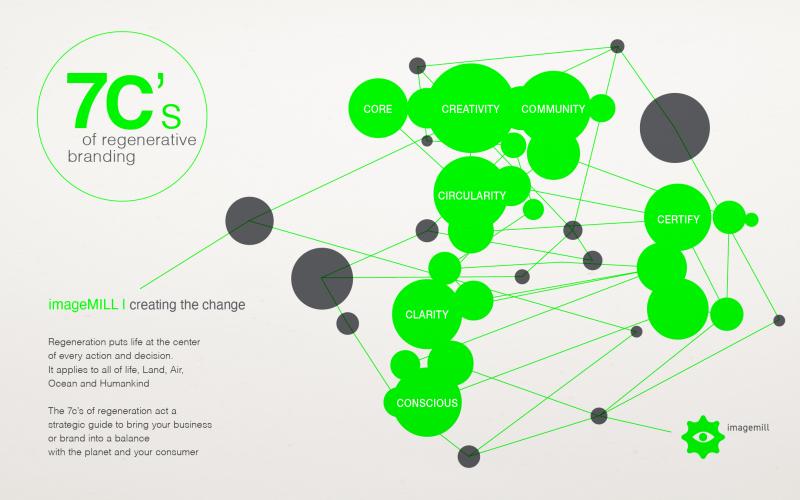Featured Article: The Regenerative 7Cs - A Framework for Business Renewal (imageMILL)
Last month we argued that sustainability is no longer enough. To meet today’s challenges, businesses must not only reduce harm but create positive impact. The question is: how can companies make regeneration real in their day-to-day operations?
At imageMILL, we use a practical framework called The Regenerative 7Cs, a blueprint for aligning purpose and profitability while building resilience. Over the next seven issues, this column will explore each C in detail.
________________________________________
The 7Cs at a Glance (through a Japanese–Irish lens)
-
CORE – Align Brand with Purpose
A regenerative business starts with integrity. What you say externally must reflect how you operate internally. This recalls Sanpo Yoshi (“three-way good”) from traditional Japanese merchants—good for seller, buyer, and society—and Ireland’s long-standing cooperative movement, both of which put values at the core of trade. -
CREATIVITY – Design for Transformation
Innovation thrives when imagination meets purpose. In Japan, Kaizen encourages continuous improvement, while in Ireland, creative industries are increasingly embedding sustainability into design and storytelling. Creativity is how regeneration becomes culturally relevant and commercially compelling. -
COMMUNITY & CONNECTION – Belong and Bond
Strong business relies on strong relationships. Japanese practices such as Nemawashi (laying groundwork through consensus) and Hourensou (report, inform, consult) echo Ireland’s tradition of community-driven business. Regenerative companies see stakeholders as partners, not just customers. -
CIRCULARITY – Design for Life Cycles
Nature wastes nothing—and historically, neither did business. In Japan, mottainai captures this respect for resources. In Ireland, family businesses and local farms thrived by reusing, repairing, and passing assets across generations. Today, circularity means redesigning products, logistics, and services to regenerate value. -
CLARITY – Speak Truth with Simplicity
Trust comes from transparency. Toyota’s Genchi Genbutsu (“go and see for yourself”) reflects the discipline of firsthand knowledge, while Ireland’s reputation for plain-spoken honesty carries weight in business dealings. Clarity means reporting progress and challenges with openness. -
CONSCIOUS – Lead with Awareness and care
Ethical leadership requires reflection and care. Japan’s Ringi decision-making system emphasizes collective responsibility, while Ireland’s cooperative boards often reflect community voices. Conscious leaders move beyond short-term profit toward long-term resilience. - CERTIFY – Build Trust with Proof
In an era of greenwashing, third-party certification is essential. B Corp, Fair Trade, ISO, or Regenerative Organic standards provide accountability. Ireland and Japan are both seeing growing numbers of certified companies—a sign of credibility in international trade.
________________________________________
Why This Matters for IJCC Members
The 7Cs are not abstract—they mirror traditions Irish and Japanese businesses already understand. Merchants in Ōmi or farmers in County Cork didn’t call it “regeneration,” but they practiced it: fairness in trade, care for community, and respect for resources. The 7Cs give us a modern, global framework to update those principles for today’s challenges.
________________________________________
Your First Step: Score Yourself
Take a quick self-assessment. For each C, rate your company from 0–2 (0 = not yet started, 1 = in progress, 2 = embedded).
- CORE: Is purpose embedded in daily operations?
- CREATIVITY: Are you innovating with impact in mind?
- COMMUNITY: Are you co-creating with stakeholders?
- CIRCULARITY: Are your systems designed for renewal?
- CLARITY: Do you report impact with honesty?
- CONSCIOUSNESS: Do leaders act with awareness and care?
- CERTIFY: Do you have external validation of your impact?
Total: /14 → your baseline score.
How to Read Your Score
- 0–4 (Foundations): Early stage. Sustainability is ad hoc or siloed. Focus first on CORE and one achievable C.
- 5–9 (Emerging): Some regenerative practices, but uneven. Choose 2–3 Cs to deepen and measure quarterly.
- 10–14 (Leading): Regeneration is embedded. The next step is to make your story visible, inspire your sector, and scale partnerships.
What to Learn from It
- The score is not a grade—it’s a conversation starter. Use it with your leadership team, not just as an individual reflection.
- Different perspectives may highlight blind spots.
- Revisit every 6–12 months. The goal isn’t perfection, but continuous improvement.
________________________________________
Closing Reflection
Irish and Japanese businesses already have the cultural DNA for regeneration. By applying the 7Cs, we can translate ancient wisdom into strategies fit for today’s global challenges. Next month, we’ll begin with the first C: CORE—aligning what you say with what you do.
________________________________________
Byline
Written by Rick Grehan, IJCC Board Member and Sustainability Committee Manager, and founder of imageMILL.

